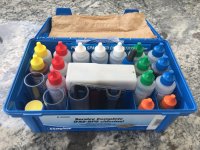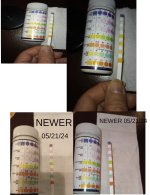Hello Folks,
About a month ago, I bought a house in Fort Wayne, IN, and the house came with an in-ground swimming pool. It was not my intention to buy a house with a pool – I bought mostly due to the location. The pool was closed due to the winter -- it was winterized with anti-freeze, etc --, so the machinery was turned off and disconnected. Don’t know much about pools in general (besides the very basics), but I have a background in engineering and have many different interest (plumbing, mechanics, etc). Did not have much time to do anything with the pool, beside skimming every other day (when I am in town) and pouring a jug of chlorine in it a few times a week to minimize the problem. As of now, the pool situation is bleak and it is green and it is dirty (it gets dirty every day given that there is no circulation and filtration and also due to the fact that there are lots of trees and plants nearby). Probably has lots of stuff accumulated on the floor of the pool. Looking at the city website for permits, it shows that the pool was built in 1996 and is 21'x35' and its deep sideis probably around 8 ft deep.
It is more than time to tackle that situation with the pool, so I developed a plan of action based on some research, etc. But there are some uncertainties and doubts, and I have a few questions and doubts:
<>Firstly, the chemical test strip results (will redo it soon in better conditions):
Total Hardness ppm => seems to be low or very low (difficult to distinguish by the color), but more likely low
Free Chlorine => seems to be 1 (which according to the chart is ok). Due to the poor conditions of the pool water, I have been pouring 1 jug of chlorine around the pool about 3 times a week.
Ph is rather low: the strips indicates 6.2 or 6.8. An electronic probe device used to measure the Ph shows it as been around 6.5.
Cyanuric Acid seems to be close to 0.
Alkalinity on the other hand looks rather high at about 180. Alkalinity keeps the Ph in check (help maintains and keep the Ph level).
=> To be more effective, the chlorine needs a balanced Ph, so the goal is to increase the Ph and then superchlorinate the pool with the pump running. Then, brush the walls and floor. Next day would vaccum the floor of the pool.
Below is a pic of the pool:
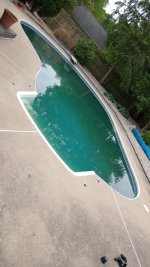
<> Checked the basket inside the pump and the skimmer.
Previously, the skimmer had some anti-freeze jugs jammed into it, due to winterization -- I guess. Removed the jugs, found out the skimmer basket in a garage's closet with other pool related things. The skimmer basket seems to come along with an insert that may go inside it – heard that it act as a door for the skimmer (replacing the flap door thing). The pic below depicts the situation:
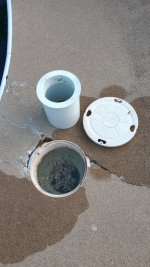
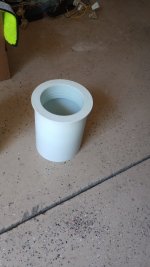
(Plastic insert thing that floats inside the skimmer and above the skimmer basket)
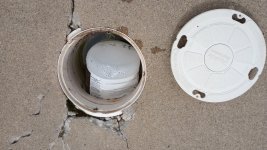
(Previous situation, with jugs jammed inside the skimmer)
The basket is not shown in the pics above, bu it is in good shape.
The pump had its basket removed, cleaned and reinstalled. No water in the pump as is to be expected, so it should need to be primed. Can the pump be run without any water just to test it?
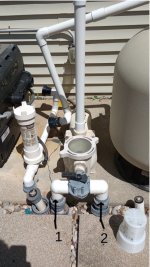
Also, the connection between the main pump body and the pump multi-port valve next to the pump body (as shown in the pic above) seems to be made by some type of epoxy and resin? Is that properly done. Looks kind of flimsy.
And to make things difficult, there is not labeling in the pipes going underground from the pump. The arrows point to them. Which likely would be the drain and which would be for the skimmer?
Previous all equipment was disconnected and some of parts (skimmer basket, plugs, o-rings, etc) were stored in a closet in the garage. Below is a pic depicting the situation before all connections, etc, were done:
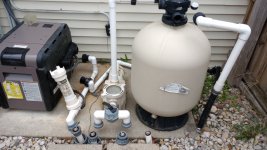
Today, I managed to reconnected everything. Lube all the o-rings and put all plugs in place. Once upon opening the pipes protruding from the ground, I noticed some anti-freeze still present. Could the residual anti-freeze be a problem? Below is a pic of the whole thing assembled:
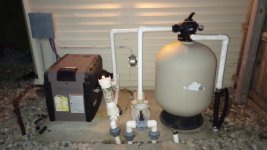
Basically, the idea is to bring the Ph back to normal levels in order to maximize the effects of the chlorine (liquid chlorine jugs with 10% chlorine content). I plan on using 3 or 4 jugs of chlorine after the Ph is at a proper level. Brush the walls and floor of the pool manually. All that should be done when the pump and filter is running.
Also, threaded two small black plugs on the side of the heater (assumed it is necessary to have them once the thing is running). I was wondering if there is way, besides installing new plumbing, valves and fittings, to bypass the heater? Does the heater has the internal capability (through solenoids) to internally be bypassed?
Thanks any input.
About a month ago, I bought a house in Fort Wayne, IN, and the house came with an in-ground swimming pool. It was not my intention to buy a house with a pool – I bought mostly due to the location. The pool was closed due to the winter -- it was winterized with anti-freeze, etc --, so the machinery was turned off and disconnected. Don’t know much about pools in general (besides the very basics), but I have a background in engineering and have many different interest (plumbing, mechanics, etc). Did not have much time to do anything with the pool, beside skimming every other day (when I am in town) and pouring a jug of chlorine in it a few times a week to minimize the problem. As of now, the pool situation is bleak and it is green and it is dirty (it gets dirty every day given that there is no circulation and filtration and also due to the fact that there are lots of trees and plants nearby). Probably has lots of stuff accumulated on the floor of the pool. Looking at the city website for permits, it shows that the pool was built in 1996 and is 21'x35' and its deep sideis probably around 8 ft deep.
It is more than time to tackle that situation with the pool, so I developed a plan of action based on some research, etc. But there are some uncertainties and doubts, and I have a few questions and doubts:
<>Firstly, the chemical test strip results (will redo it soon in better conditions):
Total Hardness ppm => seems to be low or very low (difficult to distinguish by the color), but more likely low
Free Chlorine => seems to be 1 (which according to the chart is ok). Due to the poor conditions of the pool water, I have been pouring 1 jug of chlorine around the pool about 3 times a week.
Ph is rather low: the strips indicates 6.2 or 6.8. An electronic probe device used to measure the Ph shows it as been around 6.5.
Cyanuric Acid seems to be close to 0.
Alkalinity on the other hand looks rather high at about 180. Alkalinity keeps the Ph in check (help maintains and keep the Ph level).
=> To be more effective, the chlorine needs a balanced Ph, so the goal is to increase the Ph and then superchlorinate the pool with the pump running. Then, brush the walls and floor. Next day would vaccum the floor of the pool.
Below is a pic of the pool:

<> Checked the basket inside the pump and the skimmer.
Previously, the skimmer had some anti-freeze jugs jammed into it, due to winterization -- I guess. Removed the jugs, found out the skimmer basket in a garage's closet with other pool related things. The skimmer basket seems to come along with an insert that may go inside it – heard that it act as a door for the skimmer (replacing the flap door thing). The pic below depicts the situation:


(Plastic insert thing that floats inside the skimmer and above the skimmer basket)

(Previous situation, with jugs jammed inside the skimmer)
The basket is not shown in the pics above, bu it is in good shape.
The pump had its basket removed, cleaned and reinstalled. No water in the pump as is to be expected, so it should need to be primed. Can the pump be run without any water just to test it?

Also, the connection between the main pump body and the pump multi-port valve next to the pump body (as shown in the pic above) seems to be made by some type of epoxy and resin? Is that properly done. Looks kind of flimsy.
And to make things difficult, there is not labeling in the pipes going underground from the pump. The arrows point to them. Which likely would be the drain and which would be for the skimmer?
Previous all equipment was disconnected and some of parts (skimmer basket, plugs, o-rings, etc) were stored in a closet in the garage. Below is a pic depicting the situation before all connections, etc, were done:

Today, I managed to reconnected everything. Lube all the o-rings and put all plugs in place. Once upon opening the pipes protruding from the ground, I noticed some anti-freeze still present. Could the residual anti-freeze be a problem? Below is a pic of the whole thing assembled:

Basically, the idea is to bring the Ph back to normal levels in order to maximize the effects of the chlorine (liquid chlorine jugs with 10% chlorine content). I plan on using 3 or 4 jugs of chlorine after the Ph is at a proper level. Brush the walls and floor of the pool manually. All that should be done when the pump and filter is running.
Also, threaded two small black plugs on the side of the heater (assumed it is necessary to have them once the thing is running). I was wondering if there is way, besides installing new plumbing, valves and fittings, to bypass the heater? Does the heater has the internal capability (through solenoids) to internally be bypassed?
Thanks any input.


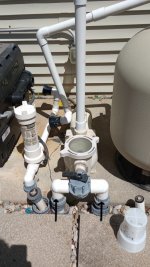
 As a new pool owner, let's be sure to take this in some simple steps:
As a new pool owner, let's be sure to take this in some simple steps: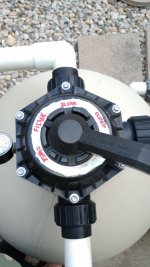
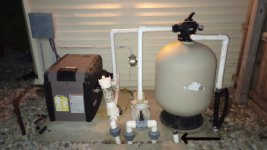
 Your filter is connected (In, Out, & Waste) and all the other lines make sense. Perhaps this was an old abandoned line for something? We can come back to that a bit later.
Your filter is connected (In, Out, & Waste) and all the other lines make sense. Perhaps this was an old abandoned line for something? We can come back to that a bit later.
